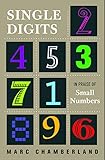Single digits : in praise of small numbers / Marc Chamberland.
By: Chamberland, Marc [author.] .
.
Material type:  BookSeries: EBL-Schweitzer.Publisher: Princeton : Princeton University Press, [2015]Copyright date: �2015Description: 1 online resource (xii, 226 pages) : illustrations, map.Content type: text Media type: computer Carrier type: online resourceISBN: 9781400865697; 1400865697.Subject(s): Mathematical analysis
BookSeries: EBL-Schweitzer.Publisher: Princeton : Princeton University Press, [2015]Copyright date: �2015Description: 1 online resource (xii, 226 pages) : illustrations, map.Content type: text Media type: computer Carrier type: online resourceISBN: 9781400865697; 1400865697.Subject(s): Mathematical analysisIncludes bibliographical references and index.
Print version record.
Frontmatter -- Contents -- Preface -- Chapter 1. The Number One -- Chapter 2. The Number Two -- Chapter 3. The Number Three -- Chapter 4. The Number Four -- Chapter 5. The Number Five -- Chapter 6. The Number Six -- Chapter 7. The Number Seven -- Chapter 8. The Number Eight -- Chapter 9. The Number Nine -- Chapter 10. Solutions -- Further reading -- Credits for illustrations -- Index.
The numbers one through nine have remarkable mathematical properties and characteristics. For instance, why do eight perfect card shuffles leave a standard deck of cards unchanged? Are there really "six degrees of separation" between all pairs of people? And how can any map need only four colors to ensure that no regions of the same color touch? In Single Digits, Marc Chamberland takes readers on a fascinating exploration of small numbers, from one to nine, looking at their history, applications, and connections to various areas of mathematics, including number theory, geometry, chaos theory, numerical analysis, and mathematical physics. Each chapter focuses on a single digit, beginning with easy concepts that become more advanced as the chapter progresses. Chamberland covers vast numerical territory, such as illustrating the ways that the number three connects to chaos theory, an unsolved problem involving Egyptian fractions, the number of guards needed to protect an art gallery, and problematic election results. He considers the role of the number seven in matrix multiplication, the Transylvania lottery, synchronizing signals, and hearing the shape of a drum. Throughout, he introduces readers to an array of puzzles, such as perfect squares, the four hats problem, Strassen multiplication, Catalan's conjecture, and so much more. The book's short sections can be read independently and digested in bite-sized chunks--especially good for learning about the Ham Sandwich Theorem and the Pizza Theorem. Appealing to high school and college students, professional mathematicians, and those mesmerized by patterns, this book shows that single digits offer a plethora of possibilities that readers can count on.
In English.
IEEE IEEE Xplore Princeton University Press eBooks Library


There are no comments for this item.